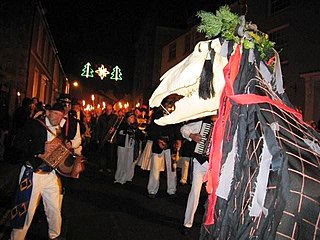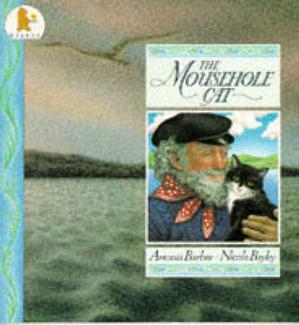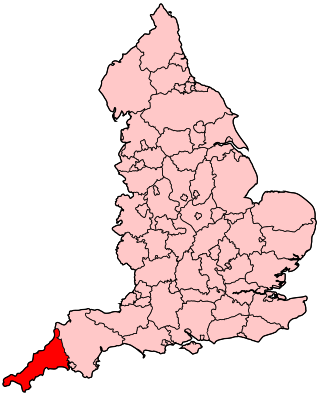
Stargazy pie is a Cornish dish made of baked pilchards (sardines), along with eggs and potatoes, covered with a pastry crust. Although there are a few variations using other types of fish, the unique feature of stargazy pie is fish heads protruding through the crust, so that they appear to be gazing to the stars.

Mousehole is a village and fishing port in Cornwall, England, UK. It is approximately 2.5 miles (4 km) south of Penzance on the shore of Mount's Bay. The village is in the civil parish of Penzance. An islet called St Clement's Isle lies about 350 metres (380 yd) offshore from the harbour entrance.

Golowan is the Cornish language word for the Midsummer celebrations in Cornwall, UK; widespread prior to the late 19th century and most popular in the Penwith area and in particular Penzance and Newlyn. The celebrations were centred on the lighting of bonfires and fireworks and the performance of associated rituals. The midsummer bonfire ceremonies were revived at St Ives in 1929 by the Old Cornwall Society and since then spread to other societies across Cornwall, as far as Kit Hill near Callington. Since 1991 the Golowan festival in Penzance has revived many of these ancient customs and has grown to become a major arts and culture festival; its central event Mazey Day now attracts tens of thousands of people to the Penzance area in late June.

Brenda Wootton was a British folk singer and poet and was seen as an ambassador for Cornish tradition and culture in all the Celtic nations and as far as Australia and Canada.

Guise dancing is a form of community mumming practiced during the twelve days of Christmastide, that is, between Christmas Day and Twelfth Night in West Cornwall, England, UK. Today, guise dancing has been appropriated for feast days at other times of the year.

Picrous Day was a festival celebrated by the tin miners of Cornwall on the First Thursday before Christmas. This is believed to be the feast of the discovery of tin by a man named Picrous whom miners in the East of Cornwall celebrated as the founder of their industry instead of St Piran.
Chewidden Thursday was a festival celebrated by the tin miners of West Cornwall on the last clear Thursday before Christmas. The festival celebrated the discovery of 'white tin' or smelted tin by St Chiwidden, a little-known Cornish saint who in legend was an associate of St Piran.
Nickanan Night is a Cornish feast, traditionally held during Shrovetide, specifically on Shrove Monday.
Tom Bawcock is a legendary character from the village of Mousehole, Cornwall, England. He appears to have been a local fisherman in the 16th century. According to the legend, one winter had been particularly stormy, meaning that none of the fishing boats had been able to leave the harbour. As Christmas approached, the villagers, who relied on fish as their primary source of food, were facing starvation.

The cultural calendar of Cornwall is punctuated by numerous historic and community festivals and celebrations. In particular there are strong links between parishes and their patronal feast days. There is also a tradition of holding celebrations associated with tin mining and fishing.

Cornish mythology is the folk tradition and mythology of the Cornish people. It consists partly of folk traditions developed in Cornwall and partly of traditions developed by Britons elsewhere before the end of the first millennium, often shared with those of the Breton and Welsh peoples. Some of this contains remnants of the mythology of pre-Christian Britain.
The Montol Festival is an annual festival in Penzance, Cornwall, England, United Kingdom, which has been held on 21 December each year since 2007. The festival is a revival or reinterpretation of many of the traditional Cornish midwinter customs & Christmas traditions formerly practiced in and around the Penzance area and common to much of Cornwall at one point. The festival spans several days, but the main events are held on the traditional date of the feast of St Thomas the Apostle, usually 21 December, which always coincides with the winter solstice.
Mummer's Day, or "Darkie Day" as it is sometimes known, is a traditional Cornish midwinter celebration that occurs every year on Boxing Day and New Year's Day in Padstow, Cornwall. It was originally part of the pagan heritage of midwinter celebrations that were regularly celebrated throughout Cornwall where people would take part in the traditional custom of guise dancing, which involves disguising themselves by painting their faces black or wearing masks.

Fishing in Cornwall, England, UK, has traditionally been one of the main elements of the economy of the county. Pilchard fishing and processing was a thriving industry in Cornwall from around 1750 to around 1880, after which it went into an almost terminal decline. During the 20th century the varieties of fish taken became much more diverse and crustaceans such as crab and lobster are now significant. Much of the catch is exported to France due to the higher prices obtainable there. Though fishing has been significantly damaged by overfishing, the Southwest Handline Fishermen's Association has started to revive the fishing industry. As of 2007, stocks were improving. The Cornwall Sea Fisheries Committee is one of 12 committees responsible for managing the corresponding Sea Fisheries District. The Isles of Scilly Sea Fisheries Committee is responsible for the Scilly district.

Cornish cuisine encompasses the cooking styles, traditions and recipes associated with Cornwall and the Cornish people. It has been heavily influenced by the geography of the county as well as its social history.

The Mousehole Cat is a children's book written by Antonia Barber and illustrated by Nicola Bayley. Based on the legend of Cornish fisherman Tom Bawcock and the stargazy pie, it tells the tale of a cat who goes with its owner on a fishing expedition in rough and stormy seas. The book has won awards, including the 1998 British Book Award for Illustrated Children's Book of the Month. It has since been adapted into a 1994 animated film, a puppet show and is being adapted as a stage musical.
Fish and Tin and Copper is a traditional folk song/ballad associated with Cornwall, and dealing with the legend of the devil visiting Cornwall and being frightened away, fearing that he'd be made into a Cornish pasty filling.

The following outline is provided as an overview of and topical guide to Cornwall: Cornwall – ceremonial county and unitary authority area of England within the United Kingdom. Cornwall is a peninsula bordered to the north and west by the Celtic Sea, to the south by the English Channel, and to the east by the county of Devon, over the River Tamar. Cornwall is also a royal duchy of the United Kingdom. It has an estimated population of half a million and it has its own distinctive history and culture.
Presented below is an alphabetical index of articles related to Cornwall:













